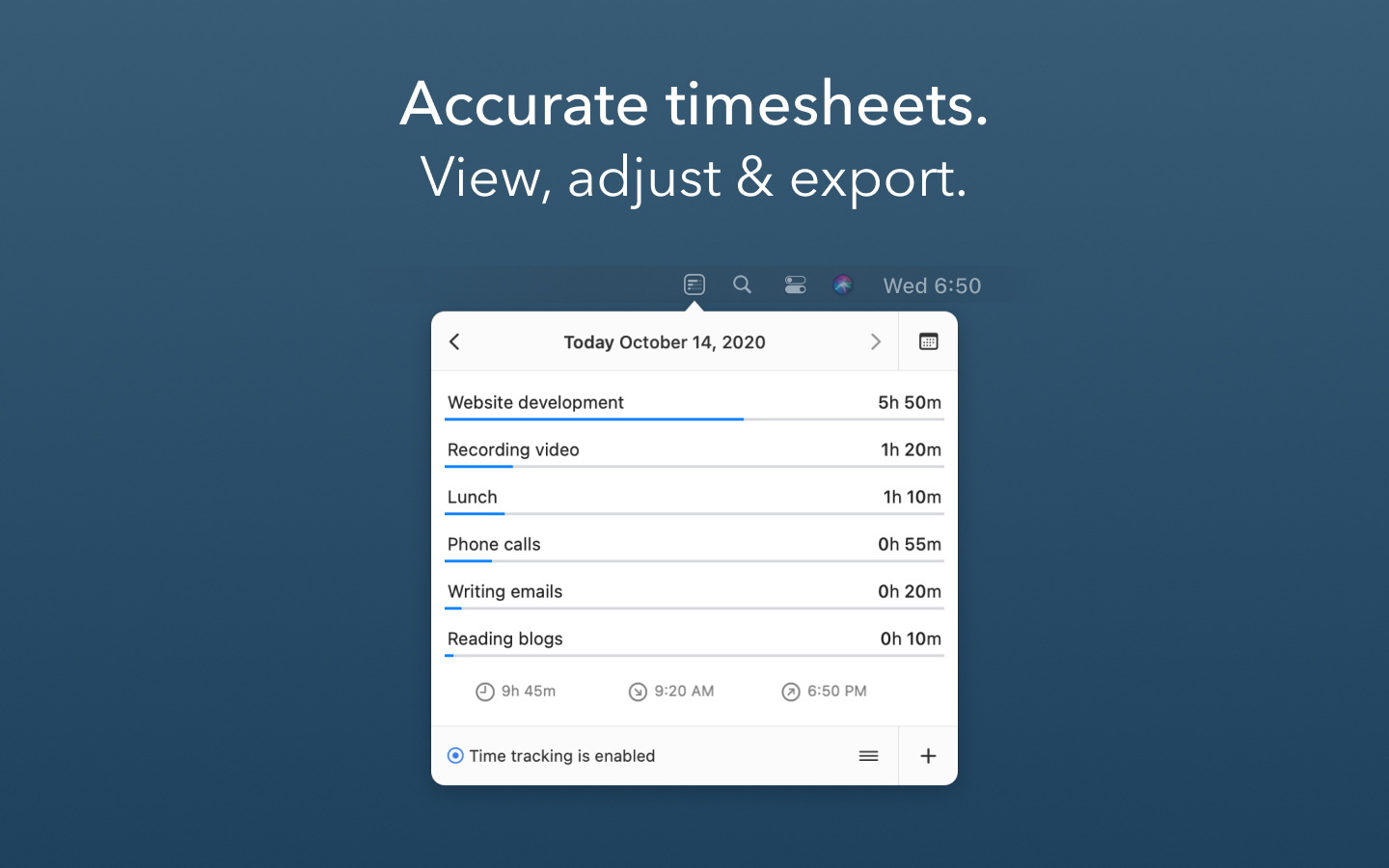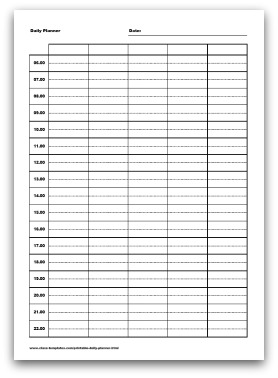- Daily Time Tracking Log
- Daily Time Tracking Spreadsheet
- Daily Time Tracking Paper Log
- Daily Time Tracker For Work
- Daily Time Tracking Spreadsheet Google Sheets
- Daily Time Tracking App
The Timeular Tracker is the world’s first 8-sided tracking dice, automatically tracking activities when flipped. Minute accurate time tracking, lightning fast Improve your focus through physical reminder No more over or under-estimating your time. Free Time Tracking software with a track record. Time tracked on projects and tasks can be easily turned into shareable reports for your clients or managers. Set hourly rates and generate invoices with ease.
UncategorizedIn this comprehensive guide we’ll discuss best practices, tips&tricks, Jira add-ons, configuration and everything else there is to know about Jira time tracking.
You may think you know how you spend your time being productive completing your tasks in Jira. But you might be surprised.
Daily Time Tracking Log
Unless you’re tracking time minute by minute you can’t really know.
Remember, what isn’t measured, can’t be improved. After all, if you’re not measuring, then you can’t know if changes make the situation better or actually make them worse.
Daily Time Tracking Spreadsheet
Besides, if you’re not tracking targets, you can’t see how far your team is meeting deadlines.
Simply put time tracking, in conjunction with the measurement of results, is critical for optimization.
Daily Time Tracking Paper Log
On a side note: Although time tracking is very powerful. I do not want to make it sound like it is the only tactic to improve performance. Additional tactics worth a mention include being results driven, measuring the number of tasks completed before deadline, etc.
Why time tracking in Jira is important for agile software development
Time tracking is particularly important for agile software development. And while not all Jira users follow agile, plenty of agile dev teams absolutely love Jira.
One of the most difficult tasks for project managers is to come up with realistic estimates. Using time tracking, in addition to other statistics (such as story points), you can compare tasks with similar jobs completed in the past. And hence calculate far more accurate deadlines.
Furthermore, you can absolutely automate time tracking
To note: marshaling a team to track time effectively can take time. And gamification techniques can be particularly effective in winning individuals around.
When to use a Jira time tracking reports
Here are a few examples of specific situations where time tracking can come in useful in Jira.
When you need:
- To provide records of the time spent on every issue and project
- To generate timesheets and customer invoices. And connect to payment processes for both clients and contractors.
- To enable work to be assessed and allocated based on real-time reporting
- To drive triangulation, allowing timing estimates to be created based on other similar projects
- To create visualizations of time spent across projects
- To integrate with third-party tools to further assist planning and time tracking
How to enable time tracking in Jira
First things first, time tracking is enabled by default in Jira.
So unless you’ve turned it off, then you don’t need to turn it on. But to turn it off…
Note: You’ll need to be an admin to take all of the following steps.
Disabling time tracking:
This is how you can disable time tracking in Jira:
- Go to ‘Settings’
- and then ‘Issues’,
- then ‘Issue Features’
- and then ‘Time Tracking’
- Click ‘Deactivate’ to disable time tracking
Note: disabling time tracking, will not delete any existing data on your instance.
Enabling time tracking:
If time tracking is disabled, this is how you can enable time tracking in Jira:
- Go to ‘Settings’
- and then ‘Issues’,
- then ‘Issue Features’
- and then ‘Time Tracking’
- Click ‘Activate’ to enable time tracking
How to configure your Jira time tracking settings
Before editing the time tracking settings in Jira, time tracking must be disabled. You can check this using the steps described above.

Note: Don’t forget to re-enable it once the desired changes have been made.
These are the simple steps to configure your Jira time tracking settings:
- Once time tracking is off, you can edit the associated settings.
- Select the values/formats for:

- Hours per day
- Days per week
- Time format
- Default Unit (minutes/hours/days/weeks)
- Legacy Mode* to use time tracking features as they worked before Jira version 4.2 (see additional information below regarding Legacy Mode)
- Copy Comment To Work Description
And again, once finished, do not forget to turn time tracking back on!
*Legacy Mode: By default, Legacy Mode is disabled if you installed Jira 4.2 or later without upgrading from an earlier version. However, if you upgraded a version prior to 4.2, it will be enabled by default.
Daily Time Tracker For Work
With Legacy Mode disabled, users can change the ‘Original Estimate’ value irrespective of work recorded on an issue. If it is enabled, however, then users can only update ‘Original Estimate’ until work is logged on the issue. And it can not be changed after this point (unless all logs are deleted). Additionally, if enabled, then changing the ‘Remaining Estimate’ in a workflow post function will also clear the ‘Original Estimate’.
You may also need to configure Work On Issues permissions.
To do this:
- From the ‘Time Tracking’ settings page, click the ‘permission scheme’ link to reach the ‘Permissions Scheme’ page.
- Find the permission scheme associated with the project that you want to edit and click the ‘Permissions’ link.
- This will take you to the ‘Edit Permissions’ page. Once there, you can review the users, groups and project roles that have permission to ‘Work On Issues’. If you’d like to add users, click the ‘Add’ button in the ‘Operations’ column.
- Work on issues
- Delete all worklogs
- Delete own worklogs
- Edit all worklogs
- Edit own worklogs
If you want to use a time tracking app, then once it is installed you can set it up from the ‘Time Tracking’ settings page.
How to generate a Time Tracking Report in Jira
These are the simple steps to creating a time tracking report in Jira for a specific project. Which is available as standard in Jira.
- Go to ‘Reports’, then ‘Forecast & management’ then ‘Time Tracking Report’.
- Select the fix version that you want a report on via the dropdown menu
- and select how you want the issues to be sorted. You can sort by:
- ‘least completed issues’ – issues with the highest estimated time remaining
- ‘most completed issues’ – which have the lowest Estimated Time Remaining.
- You can then select which Issues should be included in the dropdown. Including ‘All’, ‘Incomplete’ (excluding completed and non time-tracked issues).
- You can also select which sub-tasks are included, choosing from:
- ‘Only include sub-tasks with the selected version’
- ‘Also include sub-tasks without a version set’
- ‘Include all sub-tasks’ (which includes all sub-tasks, regardless of version).
Time tracking apps for Jira
A range of time tracking plugins are available from the Atlassian Marketplace. Some of the most popular include:
Tempo Timesheets
Tempo Timesheets is “the” premium app that sets out to take the pain out of time tracking. Making the process fast and easy. And allowing teams to choose from multiple options on how to track time.
The app allows: managers to create granular reports, to quickly approve timesheets, individually or in bulk, to drill down into time spent data by client and to manage project teams by role, capacity, workload and holiday schemes. And much, much more.
Find out more about Tempo Timesheets here
Pivot Gadget
The Pivot Gadget, from iDalko, is an advanced reporting tool which allows you to quickly visualise key information.
Effectively, the app provides business intelligence capabilities within your Jira instance. It is useful for quickly creating cross tabulations across a long list of dimensions and measurements.
Find out more about Pivot Gadget here
Work Time Calendar for Jira

Work Time Calendar allows you to plan and track time from a calendar view, working with configurable timesheets.
Daily Time Tracking Spreadsheet Google Sheets
The app also comes with start/stop timers and allows you to lock periods of time and to generate and export customizable timesheets.
Find out more about Work Time Calendar here

Time Reports
Time Reports provides flexible time tracking and reporting of time spent on Projects, Epics and Initiatives, broken down by Days, Users and Issue Statuses.
The app also allows you to pivot by users and status and to create pie charts on time spent.
Find out more about Time Reports here
Note: More about how to use Jira can be read here.
Conclusion
With this information in hand, you should have complete transparency on how your team is spending their time. And where they are getting unexpectedly bogged down.
Time tracking can also power effective resource allocation. And it allows you to make better estimates of how long tasks will take in the future.
It also allows you to remain results-orientated in real time and to retain focus.
Now, back to you. What are your thoughts on time tracking functionality in Jira? Do you have any experience with apps? Do you know other apps that might be helpful? Any tips & tricks to share? I’d love to hear it! Share your thoughts in the comments below.
Recommended Reads:
Daily Time Tracking App
- A guide to Jira workflow best practices (with examples)
- Dissecting Jira pricing: How much does a Jira license cost?
- Getting started with Trello: A Comprehensive Guide
- How to implement a Jira Migration (a step-by-step guide)
- How to set up the perfect Jira notification Scheme
- Jira Bitbucket Integration: the complete guide for 2020
- Jira Confluence Integration: The complete 2020 guide
- Key Updates of Atlassian Products 2020 (what you should know)
- Why Jira is better than Trello, even for non-developers
- 10 Expert Tips to 10x your Productivity in Jira
